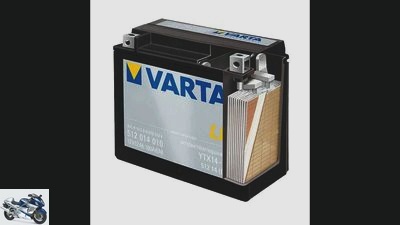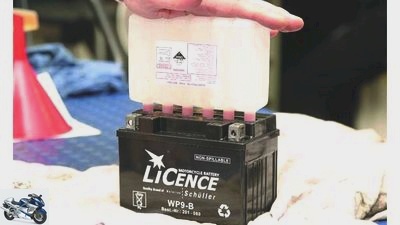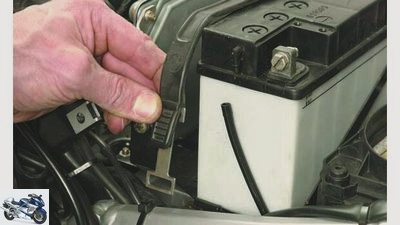Table of contents
- Adviser: the battery Everything about the battery
- Battery capacity
- Expand, load, install: this is how it works!
- Pay attention to lead-acid batteries
- battery charger
- Conversion to gel battery?
- More about technology

Varta
counselor
workshop
Adviser: the battery
Adviser: the battery
Everything about the battery
It’s almost close, the season is about to start. In order for the crankshaft to turn reliably and the engine guaranteed to start, the battery needs a lot of attention.
Franz Josef Schermer
02/28/2008
Most of the time, the battery is hidden somewhere under the paneling or the bench and works in front of you. And often little importance is attached to it, it just has to function, which it usually does. Until the moment when she doesn’t want to anymore and collapses. Then nothing works electrically anymore. So that this moment does not happen as far as possible, it is important to observe a few principles and give the battery a little affection – it will thank you with reliability!
A battery must always be in the best condition so that it can supply sufficient energy, especially during the starting process, even in cold weather: electric starter, ignition, electrical system and injection require juice, juice, juice! Today’s machines have a 12-volt electrical system; Veterans, on the other hand, as well as older 50s and 80s one with 6 volts. The same care instructions apply to 6- and 12-volt batteries.

Schermer
Fill the new MF battery with acid, then press the cap back on securely.
Maintenance-free, sealed MF batteries have been on the market for a number of years; they have almost replaced the classic lead-acid battery with the colored plugs on the top and the ventilation hose attached to the side. “MF” means “maintenance free”, which means something like “maintenance-free”. But this promise is deceptive, because every now and then the battery has to be removed, cleaned and charged. Then it will remain fully functional for more than just two or three years. With good care, a battery can live to be six or seven years old! The “maintenance-free” mainly refers to the fact that no distilled water has to be refilled because none of it evaporates from it.
A sealed MF battery does not have a vent hose because only oxygen is produced when properly charged (in contrast to conventional batteries, which also release hydrogen). This reacts on the minus plate with the hydrogen bound there and turns back into water. In this way, the battery’s fluid level always remains constant. Overcharging, however, can also produce hydrogen.
The advantage of this principle is the better use of space, because no safety cushion (“expansion volume”) is required. An MF battery is smaller and lighter. To be on the safe side, a valve is installed that opens when the pressure is overpressure and closes again when normal pressure is reached. In addition, there is a ceramic filter under the cover on the safety valve, which serves as protection against ignition or explosion.
Battery capacity

Schermer
If a battery strap is provided, it should also be attached, otherwise the battery will bob around in its seat.
The full battery capacity is primarily required for the starting process; it depends on both the displacement and the type of engine: A Japanese 1200 four-cylinder can get by with a relatively small battery (12/12 Ah or 12 V / 10 Ah), while a 1200 two-cylinder boxer (BMW) or similarly large V-engines (Ducati, Moto Guzzi, Harley) need a large battery that delivers around 19 ampere hours. 600 four-cylinder have very small 12 V / 10 Ah or 12 V / 8 Ah batteries, which are also installed at an angle or even horizontally; A 6 Ah battery is often sufficient for a 125.
Regardless of whether it is a gel battery, maintenance-free MF or lead-acid battery: A battery must be charged when its voltage is less than 12.3 volts (or 6.3 volts). This can be felt on the “tired” electric starter when it no longer cranks the engine properly (or by the flickering light when the engine is running at low speed). To measure the state of charge, the cables remain connected to the battery poles. Corresponding measuring devices are available from motor vehicle or motorcycle accessory dealers.
New battery
Before installing a new battery, it must first be filled with acid and then charged. This applies to a “non-maintenance-free” lead-acid battery as well as to a maintenance-free MF battery. Both are pre-charged dry and theoretically ready for immediate use after the initial filling with acid, but the more carefully a new battery is prepared for its first use, the longer it will last.
In the case of a lead-acid battery, the battery acid must be poured into the individual cells using a funnel. It’s a little easier with a maintenance-free MF battery.
1. Remove the adhesive tape from the filling openings of the battery.
2. Remove the protective film from the acid container. Place the acid container exactly on the filling holes of the battery and press in evenly. Important: the amount of acid and the flow rate are precisely matched to the battery. DO NOT puncture the containers believing that this is the only way the acid will flow! If the acid drainage stops, lightly bump the container with your finger.
3. After about an hour the acid has run into the battery: remove the empty acid container from the battery. Firmly press on the stopper strip, tap lightly with a rubber mallet if necessary.
4. Charge the battery according to the instructions, then let it rest for at least 30 minutes, then install it.
Expand, load, install: this is how it works!
Remove
1. The ignition is switched off! Open the battery compartment: it can usually be found somewhere under the seat bench or a side cover; now and then also under the tank (check the operating instructions).
2. First unscrew the negative pole of the battery, then the positive pole.
3. Remove the securing strap, completely remove the battery.
load
1. Clean the removed battery under warm running water, use a brush.
2. Dry the battery well. Clean the pole connections with a brass brush or emery cloth.
3. Connect the battery to the charger: first connect the positive pole, then the negative pole. In the case of lead-acid batteries, it is essential to remove ALL plugs!
4. Switch on the charger, charge the battery with a low charging voltage.
When charging, the charging currents and charging times specified on the battery (or in the instruction leaflet of a new battery) must not be exceeded because the battery can be damaged by excessive charging currents and long charging times.
4. 1 normal charge with 1/10 of the amperage of the battery, charging time 5 to 10 hours.
If the lowest charging voltage to be set on the battery charger is 1 ampere, the battery should be charged with it. This also applies to a 6 or 9 Ah battery, which should only be charged with 0.6 or 0.9 amps.
Fast charging may only take place in an emergency, slow charging is preferable.
5. Disconnect the battery from the charger: first disconnect the negative pole, then the positive pole.
After charging, let the battery rest for at least 30 minutes, so do not install it and drive off immediately.
Build in
1. Check the following before installation:
Is there a rubber pad for the battery in the battery box? If not, snip one out of acid-proof rubber, like an old car mat; If necessary, you can stick a few strips of window sealing rubber under the battery. Do not install the battery without the rubber, otherwise there is a risk of vibration damage.
Are the battery cable connections clean and free of corrosion? If not, peel off on both sides with fine 400 grade emery.
2. Note the charging date on the battery, insert the battery in the battery box.
3. Lubricate the screws with a little copper paste, this ensures good electrical contact and prevents corrosion.
4. First connect the positive cable to the battery, then the negative cable. Lay cables precisely, they must not bend excessively or chafe anywhere.
5. Put protective caps on connections.
6. Close the lid of the battery box.
Ventilation hose
If your machine is equipped with a maintenance-free MF battery and for whatever reason you are forced to install a non-maintenance-free lead-acid battery instead of a maintenance-free battery, a ventilation hose is required. This must be laid downwards without kinks, and its end must reach the open in such a way that escaping vapors do not come into contact with any part of the vehicle, otherwise ugly acid damage will occur on the machine in a very short time.
Pay attention to lead-acid batteries
! A lead-acid battery that is not maintenance-free is filled with battery acid (sulfuric acid). The liquid level drops over time due to evaporation. If it is below the mark on the battery, distilled water must be added. DO NOT use acid to refill!
! A new, non-maintenance-free battery comes with a ventilation hose that is wrapped very tightly together. The curling of the rolled tube can be stopped by heating it with a hair dryer and pulling it straight; it then retains its shape.
! Check acid density: An acid siphon, also known as an aerometer, is required to check the acid density. In order to get to the acid, the stoppers must either be pulled out or unscrewed from the holes.
Acid density is 1.26 grams per cm³: the battery is OK.
Acid density less than 1.18 grams: the battery is defective and needs to be replaced.
battery charger
If you find a charger in your grandfather’s shed that he used to charge the battery of his tractor with, then don’t hang a motorcycle battery on it, because it could break down during a charging process.
Buy a battery charger specifically for motorcycle batteries that allows you to set small charging currents. Today there are also really great electronic battery chargers which, after being connected, initially correspond with the battery for a while and check its charge and general condition. Based on these results, the charging current and charging time are set automatically (»charging curve«).
Conversion to gel battery?
So-called gel batteries, in which the acid is stored in the battery in the form of thick jelly, are relatively new. In very modern machines with electronic charge current regulators, a gel battery can generally be installed instead of an MF battery. The utmost caution is advised, however, if an older motorcycle was equipped with a “non-maintenance-free” lead-acid battery as standard and is now to be fitted with a gel battery Gel battery repeatedly receives an overly violent charge of charging current. Gel batteries also require special electronic chargers, so that buying an expensive gel battery is usually not worthwhile. With a sealed MF battery that is well cared for, you are always on the safe side.
More about technology
PS knowledge: technology
- Motorcycle technology clearly explained on 97 pages (PDF)
- From starter to spark plug
- Simple teaching of physical principles
- Tips and tricks for practitioners
To the PDF for € 9.99
#image.jpg
Related articles
-
Motorcycle mechanic tip Alternator and battery
Ralf Petersen 18th pictures Ralf Petersen 1/18 Ralf Petersen explains to us what to look out for with the alternator and battery and how to properly…
-
Product test: battery chargers
fact accesories Product test: battery chargers Product test: battery chargers 17 battery chargers in comparison Anyone who only hears a gentle click of…
-
Sdun accesories Product test battery chargers Product test: battery chargers Battery chargers for motorcycle batteries in the test Content of In order…
-
Honda presents a new battery exchange system
Motorcycle fair in Milan EICMA 2021 Presented by Honda 10 pictures Honda 1/10 The Honda Benly E was presented at the Tokyo Motor Show. Honda 2/10 In…
-
Kymco Ionex e-scooter with battery exchange system
Kymco 17th pictures Kymco 1/17 Kymco presented a new electric mobility concept at the Tokyo Motorcycle Show. Kymco 2/17 The mobile part is handled by the…
-
Honda PCX battery replacement system
Honda 14th pictures Honda 1/14 Honda had already presented the PCX electric scooter at the Tokyo Motor Show in 2017. Honda 2/14 The large scooter relies…
-
Hi-Q Tools PM1100 – Battery charger tried
Yvonne Hertler accesories Hi-Q Tools PM1100 – Battery charger tried Hi-Q Tools PM1100 Tried battery charger Polo has launched a new range of battery…
-
E-scooter with exchangeable battery from Niu
Niu 21 pictures Niu 1/21 Niu is launching the new MQi GT and is offering an early bird discount. Niu 2/21 400 euros can be saved on the purchase … Niu…
-
Yamaha EC-05 – e-scooter with battery exchange system
Yamaha 10 pictures Yamaha 1/10 The Yamaha EC-05 was developed in cooperation with the Taiwanese manufacturer Gogoro. Yamaha 2/10 He weighs 106 kilograms….
-
Battery chargers motorcycle test
fact 17th pictures fact 1/17 In a comparison test, 15 different battery chargers competed against each other. Which product won the test?? mps studio…